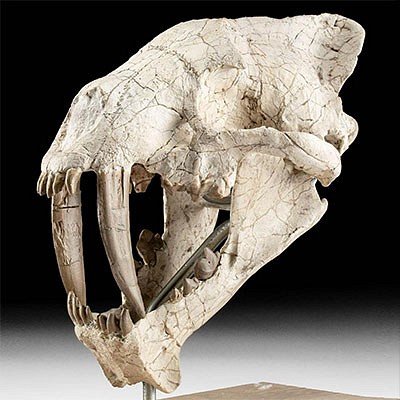Roman Stone Tesserae Mosaic w/ Hunting Scene
Lot 54
About Seller
Artemis Gallery
686 S Taylor Ave, Ste 106
Louisville, CO 80027
United States
Selling antiquities, ancient and ethnographic art online since 1993, Artemis Gallery specializes in Classical Antiquities (Egyptian, Greek, Roman, Near Eastern), Asian, Pre-Columbian, African / Tribal / Oceanographic art. Our extensive inventory includes pottery, stone, metal, wood, glass and textil...Read more
Estimate:
$7,000 - $10,000
Absentee vs Live bid
Two ways to bid:
- Leave a max absentee bid and the platform will bid on your behalf up to your maximum bid during the live auction.
- Bid live during the auction and your bids will be submitted real-time to the auctioneer.
Bid Increments
| Price | Bid Increment |
|---|---|
| $0 | $25 |
| $300 | $50 |
| $1,000 | $100 |
| $2,000 | $250 |
| $5,000 | $500 |
| $10,000 | $1,000 |
| $20,000 | $2,500 |
| $50,000 | $5,000 |
| $100,000 | $10,000 |
| $200,000 | $20,000 |
About Auction
By Artemis Gallery
Jul 13, 2021
Set Reminder
2021-07-13 12:00:00
2021-07-13 12:00:00
America/New_York
Bidsquare
Bidsquare : Fauna, Flora, Stones & Bones
https://www.bidsquare.com/auctions/artemis-gallery/fauna-flora-stones-bones-7214
Join us for a very special summer auction featuring fabulous fossils, rocks, and minerals, plus art depicting flora and fauna from antiquity to present day. This is one you won't want to miss! Artemis Gallery info@artemisgallery.com
Join us for a very special summer auction featuring fabulous fossils, rocks, and minerals, plus art depicting flora and fauna from antiquity to present day. This is one you won't want to miss! Artemis Gallery info@artemisgallery.com
- Lot Description
Roman, the Levant, Imperial Period, ca. 3rd to early 5th century CE. A gorgeous mosaic of a rectangular form comprised of hundreds of petite stone tesserae in hues of peach, citrine, chocolate, slate, cream, jet black, forest green, burgundy, and marigold. The captivating scene depicts a youthful male hunter - clad in strap-bound caligae footwear, a thigh-length tunic, and a red-and-green cape - who brandishes a bow in his right hand and quiver of arrows behind his back. His left hand is shown throwing a woven net towards a fleeing ungulate creature, perhaps a stag, while another creature is shown facing away from the hunter's right side, perhaps his horse. The creamy beige-hued ground as well as the bushy shrub next to the hunter's foot suggest that this pursuit takes place on an open field. Size (mosaic): 18.25" W x 37.375" H (46.4 cm x 94.9 cm); (backing): 19.5" W x 39.5" H (49.5 cm x 100.3 cm)
Mosaics (opus tesellatum) are some of our enduring images from the Roman world, not only for their aesthetic beauty, but also because they reveal what Romans chose to depict and see every day decorating their private and public spaces. This piece at first glance seems quite simple - a hunting scene. However, the inclusion of the stag was likely a deliberate choice to honor Diana - the goddess of the hunt, the moon, wild animals, the woods, and nature at large - who was also believed to adore stags. While impossible to know for certain, one can muse on this possibility and certainly appreciate the immense skill and technique it took to create.
In the Roman province of Syria, which encompassed most of the ancient Near East/Levant, mosaics developed as a popular art form from the 3rd to the 5th century CE. Syria was one of Rome's wealthiest provinces, but it was also far removed from Rome itself and Roman culture was overlaid on enduring cultural traditions from Hellenistic Greece and the great civilizations that came before it. Antioch-on-the-Orontes (modern day Antakya, Turkey), was the capital of northern Roman Syria, and its excavations in the 1930s revealed more than three hundred mosaic pavements - of which many embellished public baths.
This piece has been searched against the Art Loss Register database and has been cleared. The Art Loss Register maintains the world's largest database of stolen art, collectibles, and antiques.
Provenance: ex-Phoenicia Holyland Antiquities, New York, New York, USA, acquired before 2010
All items legal to buy/sell under U.S. Statute covering cultural patrimony Code 2600, CHAPTER 14, and are guaranteed to be as described or your money back.
A Certificate of Authenticity will accompany all winning bids.
PLEASE NOTE: Due to recent increases of shipments being seized by Australian & German customs (even for items with pre-UNESCO provenance), we will no longer ship most antiquities and ancient Chinese art to Australia & Germany. For categories of items that are acceptable to ship to Australia, please contact us directly or work with your local customs brokerage firm.
#165931Mounted on a concrete backing and framed. Some stone tesserae reattached with white adhesive material. A few tesserae missing as shown. Small chips to some tesserae, with light encrustations within some recessed areas. Great preservation to figural and zoomorphic forms.Condition
- Shipping Info
-
All shipping is handled in-house for your convenience. Your invoice from Artemis Gallery will include shipping calculation instructions. If in doubt, please inquire BEFORE bidding for estimated shipping costs for individual items.
-
- Buyer's Premium



 EUR
EUR CAD
CAD AUD
AUD GBP
GBP MXN
MXN HKD
HKD CNY
CNY MYR
MYR SEK
SEK SGD
SGD CHF
CHF THB
THB














